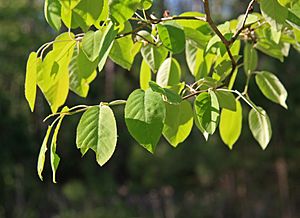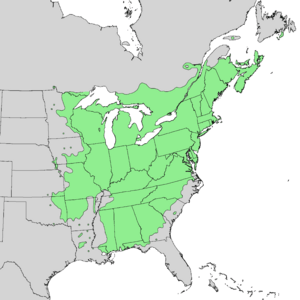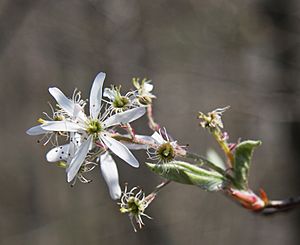Downy serviceberry facts for kids
Quick facts for kids Downy serviceberry |
|
|---|---|
 |
|
| Conservation status | |
| Scientific classification | |
| Genus: |
Amelanchier
|
| Species: |
arborea
|
 |
|
| Natural range of Amelanchier arborea | |
| Synonyms | |
|
|
Amelanchier arborea, also known as the downy serviceberry or common serviceberry, is a lovely tree or large shrub. It grows naturally in eastern North America. You can find it from the Gulf Coast all the way north to places like Thunder Bay in Ontario and Lake St. John in Quebec. It also stretches west to Texas and Minnesota.
Contents
What's in a Name?
This tree has many interesting nicknames! People sometimes call it "shadberries" because its beautiful white flowers bloom around the same time that shad fish swim up rivers in New England. Another name is "Juneberries" because its tasty berries usually ripen in June.
It's also known as "Service" or "Sarvice" berries. This name comes from a time when its blooms meant that muddy roads in the mountains of Appalachia would soon be dry enough to travel. This allowed traveling preachers to reach communities for Sunday services.
What Does the Serviceberry Tree Look Like?
The downy serviceberry tree is usually about 5 to 12 meters (16 to 39 feet) tall. Sometimes, it can grow even taller, up to 20 meters (65 feet). Its trunk can be about 15 centimeters (6 inches) wide, but sometimes it can reach 40 centimeters (16 inches). The bark is smooth and gray.
Leaves and Buds
The tree's buds are thin with a pointy tip. You can usually see more than two scales on them. The leaves are shaped like an oval or ellipse. They are usually 4 to 8 centimeters (1.5 to 3 inches) long and 2.5 to 4 centimeters (1 to 1.5 inches) wide. Their tips are pointed, and their edges are finely toothed.
A special way to identify this tree is by its young leaves. When they first appear, they are soft and fuzzy on the underside. In the fall, the leaves turn beautiful colors. They can be orange-yellow, pink, or reddish.
Flowers and Fruit
The serviceberry has perfect flowers, meaning each flower has both male and female parts. They are about 15 to 25 millimeters (0.6 to 1 inch) across. Each flower has 5 white petals. These flowers appear in early spring when the tree's buds open.
The flowers grow in hanging clusters called racemes. Each cluster is about 3 to 5 centimeters (1 to 2 inches) long and holds 4 to 10 flowers. Bees help to pollinate these flowers.
After the flowers, the tree produces fruit. The fruit is a reddish-purple pome, which looks like a small apple. These fruits ripen in the summer. They are very popular with birds, who love to eat them!
Hybrids
Sometimes, the downy serviceberry can mix with other types of Amelanchier trees. This creates a new kind of tree that shares features from both parents. One example is Amelanchier × grandiflora. Because of these mixes, it can sometimes be tricky to tell exactly which type of serviceberry tree you are looking at.
Growing Serviceberry Trees
This tree can grow in different amounts of sunlight. However, it grows best when it gets full sun. It needs soil that drains well and good air circulation around it. If there's a dry spell, it's a good idea to water the tree.
Sometimes, other similar trees are mistakenly sold as downy serviceberry in plant nurseries. You can grow new serviceberry trees from seeds. You can also grow them by dividing parts of the plant or by grafting. Grafting is when you join parts of two plants so they grow as one.
Uses for Serviceberry Fruit
The fruit of the downy serviceberry is edible, meaning you can eat it! It's a bit drier than some other serviceberry fruits. People in local areas pick these berries to make delicious pies and jams. Some have even used them to make wine.
Long ago, Native Americans used these berries to make bread. Some people say the sweetened juice of the fruit tastes like Dr. Pepper soda. Because of this, some nurseries even sell them as "The Dr. Pepper Tree." But remember, the fruit is not actually used to make the soft drink!
See also
 In Spanish: Amelanchier arborea para niños
In Spanish: Amelanchier arborea para niños



